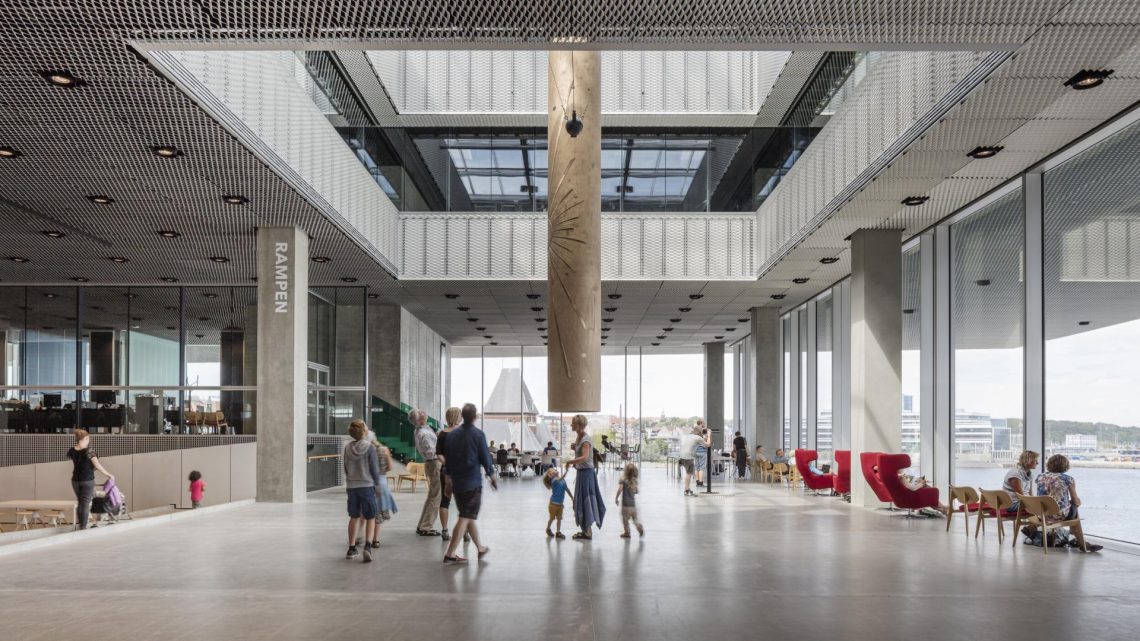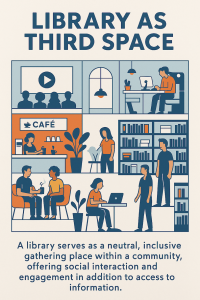
Reflection Blog: Your Neighborhood’s Living Room – The Library as Third Space
Feature Image Source: The Gong at Dokk1, which is is connected the maternity ward in Aarhus. Parents can ring The Gong when their new baby is born.
In 1931, S. R. Ranganathan, father of library science in India, famously theorized five laws of library science:
- Books are for use.
- Every reader his/her book.
- Every book its reader.
- Save the time of the reader.
- The library is a growing organism.
Today I would propose a 6th law:
- Every person their library.
The library represents an important third space in modern communities. The third space is a place that is neither work nor home, a neutral space where a person can connect with others and their hobbies or interests, or simply just be. In a world of fast-paced digital development (which libraries love!), the third space serves as a critical counterbalance, emphasizing community and that ancient art of gathering. Perhaps the library as third space doesn’t leap to the front of your mind, with their historical hush and rigid rules. But no longer are libraries simply repositories for books, a sanctuary of silent space and the whispering turn of a page. Today’s libraries have evolved into active and vibrant hubs for innovation, exploration, curiosity, inclusion, and collaboration. If the library was once the brain of the community, it is now very much its heart.

Dokk1 in Aarhus, Denmark is an example of the library evolved, the library as a community anchor. It is, of course, more than just a library. Described as “the living room of the city”, Dokk1 is a cultural center that encompasses library, theatre, concert venue, playground, café. It is a place of emerging technologies and old-school, hands-on activities for children and adults, and a champion of accessibility.
Finland’s Helsinki Central Library Oodi utilizes architecture to create a third space that is deeply integrated into the lives of its community. Its design intentionally fosters connection and personal discovery. The first floor emphasizes community engagement, with a café, movie theater, and event and lecture spaces. The second floor emphasizes creativity and collaboration with rooms for gaming, recording technology, a makerspace, and accessible tools for making art and goods. The third floor is quieter, inviting reflection and personal growth.
Libraries are the ideal third space: inclusive, democratic, free to all, and highly adaptable. These libraries don’t just house knowledge; they create hyperlinked environments that cultivate identity, belonging, and community, reflective of the people they serve.
References
American Libraries Magazine. (n.d.). Library design: Moving beyond the third place. American Library Association. https://americanlibrariesmagazine.org/blogs/the-scoop/library-design-moving-beyond-third-place/
Dokk1. (n.d.). Dokk1 – English. Aarhus Libraries. https://www.dokk1.dk/english
Helsinki Central Library Oodi. (n.d.). Welcome to Oodi. https://oodihelsinki.fi/en/
ThisisFINLAND. (n.d.). Helsinki invests in its people with a library that reinvents the genre. Ministry for Foreign Affairs of Finland. https://finland.fi/life-society/helsinki-invests-in-its-people-with-a-library-that-reinvents-the-genre/
Singh, M. (2017, September 19). Five laws of library science by Dr. S. R. Ranganathan. Librarianship Studies & Information Technology. https://www.librarianshipstudies.com/2017/09/five-laws-of-library-science.html

4 Comments
Elena
Chandler,
I love this blog; it was a pleasure to read. I totally agree with the concept of a community living room. English society always had the local pub as the community living room, (and traditionally, all ages were welcome for this reason,) and I often consider our “small town library” in the same vein. It’s a place to be yourself and discover, learn, inquire, and be accepted. I love that you can go to a library without an agenda, and leave with new information to apply to your life. It’s an amazing facility and concept.
All the best to you,
Elena
Mei C.
Hi Chandler!
I absolutely agree with you that the library functions as one of the last remaining third spaces in our society, and that they’re needed more than ever. And your law, Every person their library, is a perfect way of looking out at what the library can be, especially when considering what we’re working on in this class. If the library is a set of ideals that can be overlaid onto public spaces, then almost anywhere that considers the principles of the hyperlinked library and puts them into practice can then be considered a type of library space–which in turn makes the library, as it were, more accessible to a greater swath of people.
Cheers!
Mei
Kristin Hirst
Hi Chandler,
I love your idea of the 6th law, “Every person their library”. I think it really encapsulates the heart of the hyperlinked library model and sends the message that the library can and should be a place that people can take ownership in and really feel like it is “theirs”. I love the concept of the library in Finland that you shared, where each floor has a different purpose and there really is something there for everyone. I totally agree that libraries are the ideal “third place”, that they go beyond books and knowledge to be an inclusive space for everyone.
Great post!
-Kristin
Chandler Florence
@michael tagging you in case this gets lost in the feed!